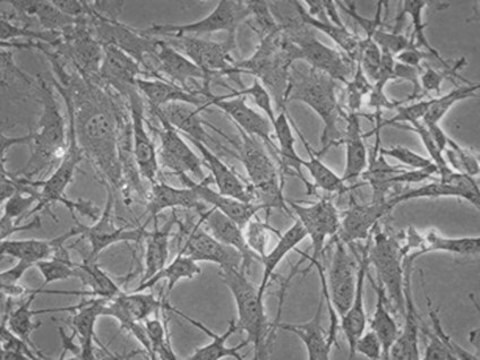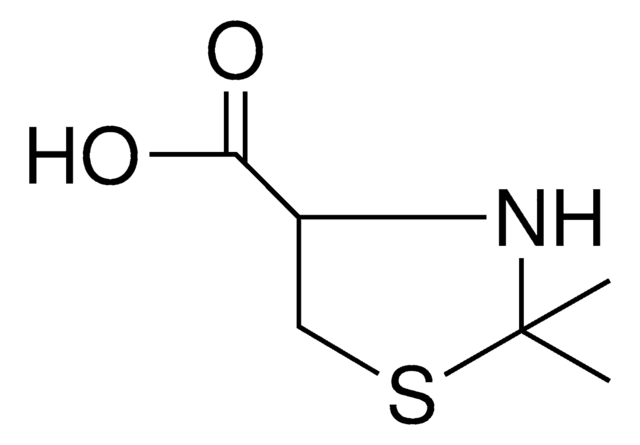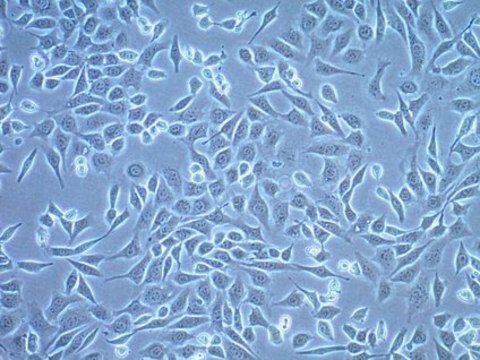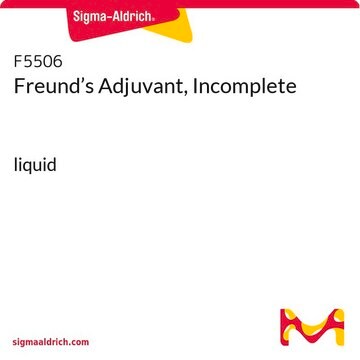SCC495
Mouse OP9-DL4 Notch Ligand Cell Line (-GFP)
Synonim(y):
Linia komórkowa DL4, Linia komórkowa OP9-DL4, Linia komórkowa delta-like 4, Linia komórkowa ligandu Notch, OP9-DL4
Zaloguj sięWyświetlanie cen organizacyjnych i kontraktowych
About This Item
Kod UNSPSC:
41106514
NACRES:
NA.81
Polecane produkty
pochodzenie biologiczne
mouse
Poziom jakości
opakowanie
vial of ≥1X10⁶ cells/vial vial
producent / nazwa handlowa
Millipore
metody
cell culture | mammalian: suitable
Warunki transportu
liquid nitrogen
temp. przechowywania
−196°C
Zastosowanie
- Każda fiolka zawiera > 1X106 żywych komórek.
- Komórki są testowane pod kątem chorób zakaźnych za pomocą Mouse Essential CLEAR Panel firmy Charles River Animal Diagnostic Services.
- Komórki zostały zweryfikowane jako pochodzące od myszy i są ujemne pod względem zanieczyszczenia międzygatunkowego pochodzącego od ludzi, szczurów, chomików chińskich, chomików syryjskich złocistych i naczelnych (NHP) zgodnie z panelem Contamination Clear firmy Charles River Animal Diagnostic Services.
- Komórki nie są skażone mykoplazmą.
Cechy i korzyści
OP9-DL4 (-GFP) to stabilna linia komórek zrębowych pochodzących ze szpiku kostnego, wykazująca ekspresję ligandu Notch-Delta like 4 (DL4) z usuniętym regionem kodującym GFP do zastosowań związanych z różnicowaniem komórek macierzystych.
Opis wartości docelowych
OP9-DL4 to stabilna linia komórek zrębu pochodząca ze szpiku kostnego, wykazująca ektopową ekspresję ligandu Notch - Delta like 4 (DL4).
Sygnalizacja Notch kontroluje wiele decyzji dotyczących losów komórek. U ssaków zidentyfikowano cztery receptory Notch (Notch 1- Notch 4). Receptory te oddziałują z ligandami Notch należącymi do rodziny Jagged lub Delta-like (DL). Następnie dochodzi do rozszczepienia wewnątrzkomórkowej domeny Notch i jego późniejszej translokacji do jądra, gdzie wiąże się z czynnikami transkrypcyjnymi i aktywuje transkrypcję różnych genów docelowych. Sygnalizacja Notch jest niezbędna we wczesnych zobowiązaniach linii komórek T. Komórki progenitorowe szpiku kostnego wyrażające konstytutywnie aktywny Notch rozwijają się raczej w podwójnie dodatnie limfocyty T CD4 i CD8 niż limfocyty B. Odgrywają one również ważną rolę w rozwoju pojedynczo dodatnich komórek CD4+ i CD8+ z podwójnie dodatnich tymocytów prekursorowych, a także w rozwoju komórek T z receptorami TCR αα+. Wykazano, że spośród 4 receptorów Notch, sygnalizacja receptora Notch1 (N1) jest wystarczająca do rozwoju komórek T. Ligandy podobne do delta są fizjologicznie istotnymi ligandami N1. DL1 oddziałuje zarówno z N1, jak i Notch 2 (N2), indukując zaangażowanie linii komórek T. Jednak DL4 oddziałuje specyficznie tylko z N1 i wspiera zaangażowanie i dojrzewanie komórek T zarówno in vitro, jak i in vivo. Co więcej, wyniki poprzednich badań wiązania pokazują, że wiązanie między DL1 i N1 jest słabe, w przeciwieństwie do silniejszego wiązania między DL4 i N1. Spośród ligandów delta podobnych do DL1 i DL4, DL4 wykazuje większą zdolność do aktywacji szlaku Notch w hematopoetycznych komórkach progenitorowych.
Linia komórkowa SCC495 OP9-DL4 ma usunięty region kodujący GFP z oryginalnego plazmidu pMiGR, co skutkuje brakiem ekspresji GFP dla tej linii komórkowej.
Źródło
Komórki OP9-DL4 zostały genetycznie zmodyfikowane z komórek zrębowych OP9 pochodzących ze szpiku kostnego myszy.
Referencje
1. Immunity 2002, 17(6): 749-756.
2. J Orthop Sci. 2005, 10(6): 589-594.
3. Curr Opin Immunol. 2007, 19(2): 163-168.
4. Cold Spring Harb Protoc. 2009, 2009(2): pdb.prot5156.
Sygnalizacja Notch kontroluje wiele decyzji dotyczących losów komórek. U ssaków zidentyfikowano cztery receptory Notch (Notch 1- Notch 4). Receptory te oddziałują z ligandami Notch należącymi do rodziny Jagged lub Delta-like (DL). Następnie dochodzi do rozszczepienia wewnątrzkomórkowej domeny Notch i jego późniejszej translokacji do jądra, gdzie wiąże się z czynnikami transkrypcyjnymi i aktywuje transkrypcję różnych genów docelowych. Sygnalizacja Notch jest niezbędna we wczesnych zobowiązaniach linii komórek T. Komórki progenitorowe szpiku kostnego wyrażające konstytutywnie aktywny Notch rozwijają się raczej w podwójnie dodatnie limfocyty T CD4 i CD8 niż limfocyty B. Odgrywają one również ważną rolę w rozwoju pojedynczo dodatnich komórek CD4+ i CD8+ z podwójnie dodatnich tymocytów prekursorowych, a także w rozwoju komórek T z receptorami TCR αα+. Wykazano, że spośród 4 receptorów Notch, sygnalizacja receptora Notch1 (N1) jest wystarczająca do rozwoju komórek T. Ligandy podobne do delta są fizjologicznie istotnymi ligandami N1. DL1 oddziałuje zarówno z N1, jak i Notch 2 (N2), indukując zaangażowanie linii komórek T. Jednak DL4 oddziałuje specyficznie tylko z N1 i wspiera zaangażowanie i dojrzewanie komórek T zarówno in vitro, jak i in vivo. Co więcej, wyniki poprzednich badań wiązania pokazują, że wiązanie między DL1 i N1 jest słabe, w przeciwieństwie do silniejszego wiązania między DL4 i N1. Spośród ligandów delta podobnych do DL1 i DL4, DL4 wykazuje większą zdolność do aktywacji szlaku Notch w hematopoetycznych komórkach progenitorowych.
Linia komórkowa SCC495 OP9-DL4 ma usunięty region kodujący GFP z oryginalnego plazmidu pMiGR, co skutkuje brakiem ekspresji GFP dla tej linii komórkowej.
Źródło
Komórki OP9-DL4 zostały genetycznie zmodyfikowane z komórek zrębowych OP9 pochodzących ze szpiku kostnego myszy.
Referencje
1. Immunity 2002, 17(6): 749-756.
2. J Orthop Sci. 2005, 10(6): 589-594.
3. Curr Opin Immunol. 2007, 19(2): 163-168.
4. Cold Spring Harb Protoc. 2009, 2009(2): pdb.prot5156.
Przechowywanie i stabilność
Komórki OP9-DL4 (-GFP) powinny być przechowywane w ciekłym azocie. Komórki mogą być hodowane przez co najmniej 10 pasaży bez znaczącego wpływu na ekspresję i funkcję markerów komórkowych.
Inne uwagi
Ten produkt jest przeznaczony do sprzedaży i sprzedawany wyłącznie instytucjom akademickim do wewnętrznego użytku akademickiego zgodnie z warunkami "Umowy o użytkowaniu akademickim", jak wyszczególniono w dokumentacji produktu. Aby uzyskać informacje na temat innych zastosowań, prosimy o kontakt z l
Oświadczenie o zrzeczeniu się odpowiedzialności
O ile nie określono inaczej w naszym katalogu lub innej dokumentacji firmy dołączonej do produktu(-ów), nasze produkty są przeznaczone wyłącznie do użytku badawczego i nie mogą być wykorzystywane do żadnych innych celów, w tym między innymi do nieautoryzowanych zastosowań komercyjnych, zastosowań diagnostycznych in vitro, zastosowań terapeutycznych ex vivo lub in vivo lub jakiegokolwiek rodzaju konsumpcji lub zastosowania u ludzi lub zwierząt.
Ta strona może zawierać tekst przetłumaczony maszynowo.
Kod klasy składowania
10 - Combustible liquids
Klasa zagrożenia wodnego (WGK)
WGK 3
Temperatura zapłonu (°F)
Not applicable
Temperatura zapłonu (°C)
Not applicable
Certyfikaty analizy (CoA)
Poszukaj Certyfikaty analizy (CoA), wpisując numer partii/serii produktów. Numery serii i partii można znaleźć na etykiecie produktu po słowach „seria” lub „partia”.
Masz już ten produkt?
Dokumenty związane z niedawno zakupionymi produktami zostały zamieszczone w Bibliotece dokumentów.
Nasz zespół naukowców ma doświadczenie we wszystkich obszarach badań, w tym w naukach przyrodniczych, materiałoznawstwie, syntezie chemicznej, chromatografii, analityce i wielu innych dziedzinach.
Skontaktuj się z zespołem ds. pomocy technicznej








